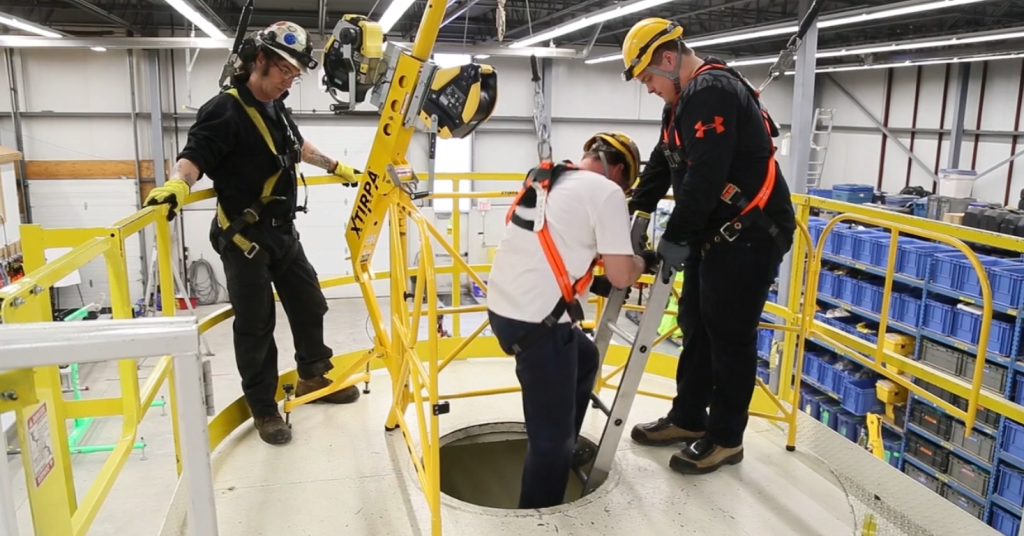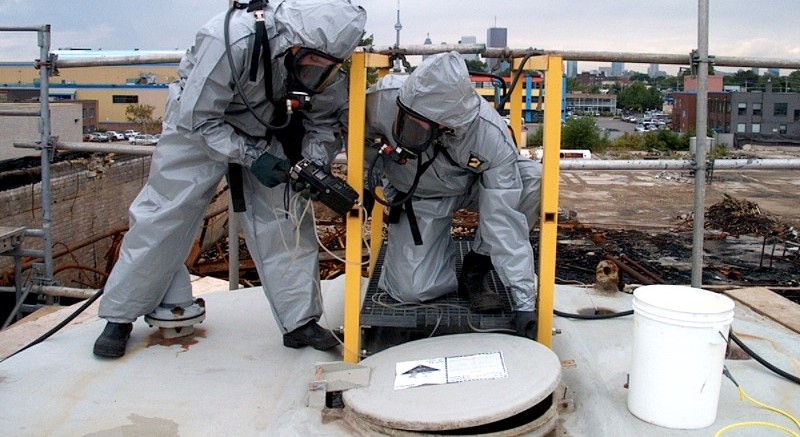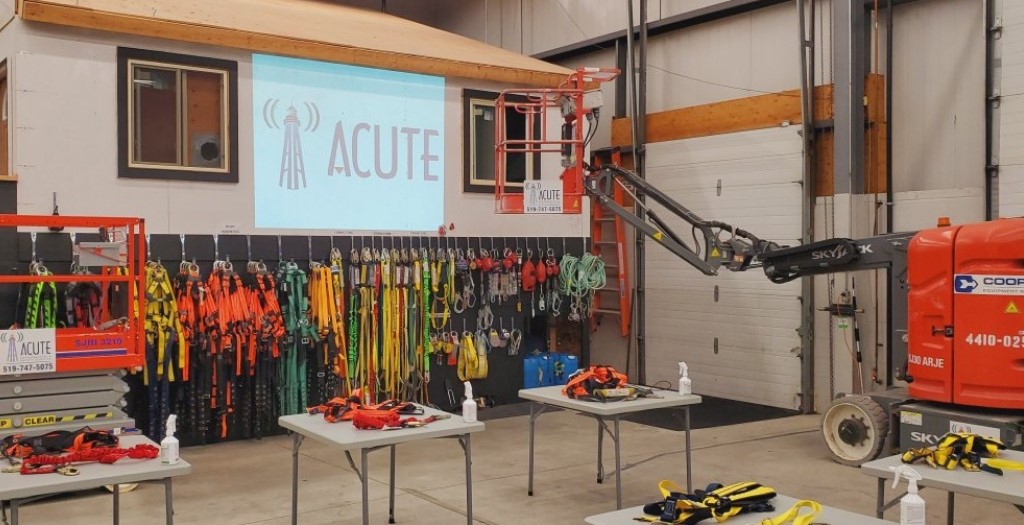Confined spaces present unique challenges for workers regardless of the industry they operate in. In this article, we will explore what confined spaces are, why they are dangerous, and why confined space training is important.
Click on each link to jump ahead to that corresponding section.
- What are Confined Spaces?
- Why are Confined Spaces Dangerous?
- Why is Confined Space Training Important?
If your business is located in Ontario, ACUTE Environmental offers a variety of training courses to fit your needs. Contact the professionals at ACUTE today to learn more.
1. What are Confined Spaces?

It is important to understand what confined spaces are and why they are dangerous
The Infrastructure Health and Safety Association (IHSA) defines confined spaces as a place that is partially or fully enclosed that is not designed for continuous human occupancy. Due to their general design, confined spaces often contain limited ventilation, which can make them hazardous.
Some general examples of confined spaces include:
- Sewers and manholes
- Tunnels and underground chambers
- Boilers and furnaces
- Storage bins and hoppers
- Pipelines and pits
Because confined spaces can be hazardous, it is important to take proper precautions when entering them. Workers who need to enter confined spaces should receive specialized training and use specialized equipment to ensure their safety.
To promote workplace safety, employers should have a written confined space entry program or document that outlines the procedures for entering, working in, and exiting confined spaces safely.
2. Why are Confined Spaces Dangerous?

Confined spaces present many unique risks, be careful!
There are several reasons why confined spaces can be dangerous. Here are some of the most common hazards associated with confined spaces:
Entrapment and Engulfment
Given that confined spaces can be small and tight, it is particularly difficult to move around or escape in the event of an emergency.
Therefore, it is critical that workers do a number of things prior to entering a confined space, such as:
- Critically examine the confined space for hazards prior to entry
- Implement proper safety procedures such as PPE, safety harnesses, and retrieval systems
- Receive proper training on the hazards of confined spaces, how to enter and work in confined spaces, and emergency response procedures.
By implementing measures like the ones above, you can help prevent confined space entrapment and ensure the safety of workers who enter these dangerous spaces.
Lack of Oxygen
Confined spaces may have a limited supply of fresh air, which can cause a lack of oxygen. This can lead to suffocation, unconsciousness, and in more extreme cases, death.
The National Fire Protection Association (NFPA) states that “lack of oxygen is the leading cause of death in confined spaces”. Therefore, it should be taken extremely seriously.
Low levels of oxygen can lead to:
- Impaired judgement
- Lack of coordination
- Changes in behaviour
- Dizziness
- Fatigue
- Collapse and death
An excellent precautionary practice to prevent exposure to low oxygen is to test for air quality, side to side and top to bottom, prior to entry.
It is critical that workers understand the risks of low oxygen levels and that they take the necessary precautions prior to entering confined spaces.
Fire and Explosion
According to the Canadian Centre for Occupational Health and Safety (CCOHS), confined spaces can also present a risk of fire or explosion due to the presence of flammable gases, liquids, or combustible dust. If these materials come into contact with a spark or a heat source, they can ignite and cause a fire or explosion.
To prevent the risk of a fire or explosion, workers should ensure that hot work (work where a source of ignition is produced) is not normally practiced in a confined space. If this is not possible, all flammable vapours, liquids, and gases must be removed prior to the start of hot work.
Other preventable measures you can take include:
- Surfaces consisting of combustible material should be shielded or cleaned
- Do not bring fuel into the confined space
- Check that your welding equipment is in good working condition
- Use spark-resistant tools whenever possible
Always ensure that prior to working in a confined space, you eliminate all potential hazards.
In addition to entrapment and engulfment, the lack of oxygen, and fire and explosion, confined spaces are also dangerous because:
- They present physical hazards exacerbated through various degrees of temperature, lighting, and noise
- They present safety hazards such as the potential for slips and falls
- They present biological hazards through the spread of viruses and bacteria
- Pedestrian traffic
- Visibility issues
For a complete list of confined space hazards, take a look at the CCOHS website.
3. Why is Confined Space Training Important?

Ensure you and your workers engage in confined space training
Confined space training is important for a number of reasons, such as:
- It ensures safety by reducing risks
- It ensures you are compliant with the OHSA
- It helps you perform your jobs more efficiently
- It ensures your workers are confident by reducing anxiety and stress, thus improving job performance
For answers to some frequently asked questions concerning confined space training, such as “Is confined space training mandatory?” and “Does confined space training expire?”, click here.
Confined Spaces Training by ACUTE Environmental

You can rely on ACUTE for all your training requirements
If you are looking for high-quality confined space training, book a course with ACUTE. You can train at our world-class training facility, or we can come to your site to do the training, the choice is yours.
ACUTE is dedicated to workplace safety training and understands just how important it is.
Here are some of the benefits of working with ACUTE:
- Open Door Instructor-Student Partnership – ACUTE’s training services emphasize client participation, staff foster relationships with clients and serve as a touchstone for advice anytime moving forward.
- Serving Your Team and Industry – With a vast array of clients in manufacturing, construction, health, academic, and government sectors, ACUTE brings the best safety practices from across the spectrum to your workplace.
- 100 Years Combined Experience – ACUTE provides comprehensive health and safety training, on-site safety services, and consulting services. With over 100 years of combined experience, our company staff offers more than theoretical or abstract ideas. ACUTE offers solutions!
- Track Record of Success – ACUTE is rated 4.9/5 stars on Google reviews, demonstrating a commitment to our clients, quality, and passion for training.
Take a look at our course calendar, and find a date that works for you. We offer courses such as:
- Advanced Working at Heights and Rescue
- Lift Truck Operator
- Elevating Work Platforms
- Confined Space Rescue
For a complete list of our training courses, click here.
Hours of Operation and Contact Information:
Monday-Friday: 8:00 AM – 5:00 PM
Saturday-Sunday: Closed
Phone: (519) 747-5075
Fax: (519) 747-4608
Email: info@acuteservices.com
What Our Customers Are Saying…
We were referred to ACUTE on behalf of our employer for an n95 mask fitting – the staff here are professional, personable, and informative.
I’d come back here for any safety-related training in a heartbeat.
Acute has been a staple in supporting my companies over the years and have always delivered quality and dependable service. Training programs are top shelf and a great facility for practical application. couldn’t recommend them more. keep up the great work folks.
Acute is recognized and respected as a people organization and they have been doing it right for a long time.

